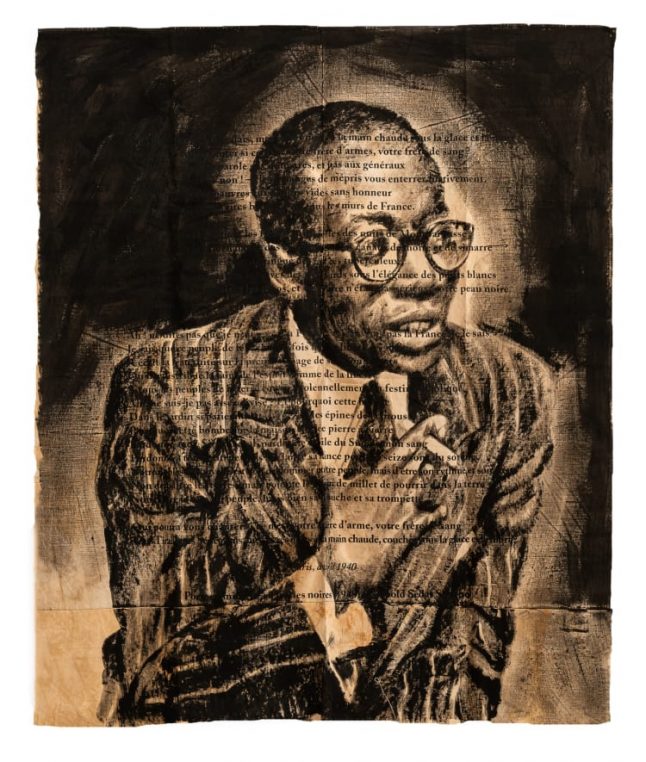Before being elected the first President of the Republic of Senegal in 1960, Léopold Sédar Senghor, 1906-2001, had been twice minister in the French Government, under Edgar Faure and Michel Debré. He was the first African to become Agrégé de grammaire in 1935 and the first African to enter the Académie Française. He is remembered as the founder of the movement of Negritude with Aimé Césaire and a great poet, who asked Maria-Helena Vieira da Silva, Hans Hartung, Pierre Soulages, Marc Chagall and Zao Wou Ki to illustrate his poems and exhibited Pablo Picasso in 1972 in Dakar. His lifetime passions were the French language and culture which he always dissociated from the country of France. The show at Musée du Quai Branly “Senghor and the arts” is based on a donation by Jean Gérard Bosio, a former diplomatic and cultural adviser to Senghor and Abdou Diouf in Senegal.
The first painting of the show is a portrait of Senghor by Roméo Mivekannin, a contemporaray artist, who worked on a photograph from 1949, when he was a delegate at the Assembly of the European council in Strasbourg. The words of his poem “Hosties noires” (1948) are superimposed on the painting. This is when he declared that he wanted to tear up “all the Banania smiles on the walls of France”. Banania was the favorite chocolate powder for children at the time and its advertisement featured a smiling African.
In the 1930’s, Senghor embarked on his intellectual and political career by participating in International discussions denouncing racism, colonialism and segregation. One of the themes of these transatlantic exchanges (involving African Americans, Antillans and Africans), was the recognition of the arts of Africans and the African Diaspora. He organized the first World Festival of Negro Arts in Dakar in 1966 under the tutelage of UNESCO, the works of which were later exhibited at Grand Palais in Paris. He had already organized with the magazine, “Présence Africaine“, the first Congress of Black writers at the Sorbonne in September 1956.

Maya Bracher, photo for UNESCO on the first World Festival of Negro arts in Dakar in 1966. Musée d’Ethnographie de Neuchâtel
Another strong moment of the show is the foundation of the Manufacture nationale of tapestry in Thiès, 40 miles East of Dakar. President Senghor understood very early that art was a great diplomatic tool and he always brought artistic presents when he travelled. The “Mystic bird” by Modou Niang showed at the beginning of the exhibition, was acquired by Mobilier national in 1993. It is a classical tapestry done in the style of Lurçat and woven by Senegalese artists who trained in Beauvais.
In 1965, Senghor inaugurated a National Theater with 1200 seats, where Macbeth was played in 1968 and which became a mine of future talents. The painter Ibou Diouf created the decors and the movie maker Djibril Did Mambety became an actor there. In 1966 he inaugurated le Musée Dynamique, the dynamic museum where he exhibited drawings by Leonardo da Vinci, Marc Chagall, Pablo Picasso, Chinese paintings, Pierre Soulages, Fritz Hundertwasser and many Senegalese artists.
Senghor shared with President Pompidou a love for poetry and contemparary art and his Elegy to the dead president was illustrated by Vieira da Silva.
This short exhibition sponsored by Marc Ladret de Lacharrière and curated by Mamadou Diouf, Professor at Columbia University, Sarah Ligner, curator and Sarah Frioux-Salgas, archivist, at Musée du Quai Branly, is very interesting for anyone who is curious about the beginnings of African Identity. Senghor was a hero of my youth and one gets a little closer to him in the show.
“Senghor et les Arts” at Musée du Quai Branly until November 19.
Share this Post






One Comment on “Léopold Sédar Senghor, an African ruler who loved the arts”
My father was the second American ambassador to Senegal after independence. He became a friend and a great admirer of Senghor. Four months after he became ambassador he brought Senghor to the White House to meet JFK.
Thirty years later I met Jackie and asked her if she remembered Senghor’s visit.
“Of course I remember it ,” she said.
“Jack showed him we had impressionist paintings. I showed him I had his poetry—in paperback!”
Here is a photo of Senghor, Kennedy and Phil Kaiser arriving on the White House lawn after a ride on Marine One from Andrews.
https://images.app.goo.gl/3JnU3mA1e6P6vchn7